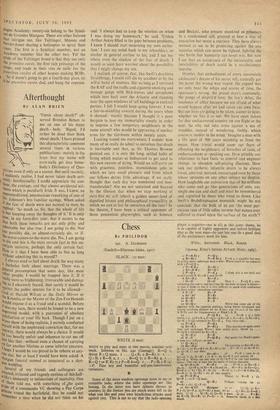Chess
By PHILIDOR 241. A. ELLEKMAN (Guidelli—Ellerman folder, 1917)
BLACK it men) WHITE (8 men)
WHITE to play and mate in two moves; solution next week. Solution to No. 240 (Gamage): R—Q 1, threat R x Q mate. t . . . Q x R; 2 B—Kt 2. 1 . . . Qx B; 2 R—K 2. t. . . B—Q 7; 2 R—Kt 4. 1 . . R—Q 7 or K Kt 7; 2 P—R 8...Q. P x B; R (4) x P. Fine key and beautiful self-pin/interference variations.
Some of the more modern openings stem to me to resemble judo, where the older openings are like boxing. In the latter you have definite threats to counter; in the former you are much more left to do what you like and your own injudicious attacks used against you. This is not to say that the judo opening player is negative—not at all; as this game shows, he is as capable of highly aggressive and indeed brilliant play as the next man—he just lets you do a good deal of the preliminary work for him.
White, ANTOSHIN. Black, RABAR. Opening, KING'S INDIAN ATTACK (BAKU, 1965).
.3 P—K Kt 3 P—Q 4
8—Kt 2 P—K Kt 3 P—K 4 is playable but may be a little more ambitious than is wise; White could set up pressure with 3 P—Q B 4. , 3 P—K 134 B—Kt 2 4 Kt—K B3 Kt—Q P—Q 3 P—K 4 1 think this is too bold and would prefer .K Kt--B 3KaindKOTO.
6 Kt—B 3
7 0-0 0-0 Here 7 . . . P—tzt B 3 con- solidating the centre and deleying the decision to castle is better— al least I think so, but it is very difficult to speak with confidence in these rather ,,morphous openings.
8 P P
KtKt :• Kt Bxxit
zo It—R 6 B—Kt z z B K B
rs Q—Q 2 . . . White has come out of the opening with the superior position, being better developed and having attacking chances on the King's side becau.,e of his open K B file and the disappearance of Black's K B. P—Q B3 12 . . . 3 is a little better, e.g.. 13 P—K 4, P—CA.5; Kt—K 2, Kt—B 3; 15 Kt—I3 4, Q--K 2 or Q3 followed by Kt—K 4. Text loses 11171e. 13 P—K 4 P—Q5 K—Kt 5 This maniruvre again costs time andK
athreficganges White's least useful piece. Better 54 . . . P—Q H 4 followed by Kt—B 3. •
15 R-11 3! BsB
16 R B
P
is now very difficult anyway.
r7 II 4 Not good, biz! Black's game ,i 17 Q-1:15! R—B z . . . Threatening 19 Kt—R3 ch, 18 kt—li 4! K—Kt 1; 20 Kt—B 6 ch. K—Kt 2 (20 ...K— R 1?; 21 Q—R 6); 21 1Q— K5! and wins. 8 .. Kt—Kt z 18 . . P—B 3 loses to 19 Kt—K 6 ch, K—Kt 1 or R 1; so Q—R 6 and against t8 . . . Kt—I3 3 White can just play t9 QxBP if he can find nothing better. The text at least has the merit of losing elegantly. 19 Q—K g eh- K—R 3 19 • P—B 3; 20 Kt—K 6
ch, t9 ... Q-43 3; so Kt—R 5 ch and x9 Kt—B 3; 20 Kt—Q 5, R—B 3; 21 K1 X Kt, R x Kt (21 R—K 3; 22 KI—K 8 dble ch,
K—R 3; 2,3 q—Kt 7 ch) all lose quietire 21 R—R 3 ch,y Threat . JO P—ti Itt 4 . . . T Q—R 5; 22 R s Q mate. Q-133 Perhaps hoping for 21 P—Kt 5 ch?, Q x P chi s/ Kt—K 67! Resigns (a) 2t. . . Q Q; 22 R- R 3 ch, Q—R 4: 23 P—Kt 5 mate. (b) 21 Q X Kt; 22 R—R 3 mute. (2) 21 . . . Q x R_; 22 Q—Kt 5 MOM (d) 21 . P zKt; u R x Q, Kt x R; 23 P—Kt 5 eh. Beautiful finish to a bae attack.




























 Previous page
Previous page